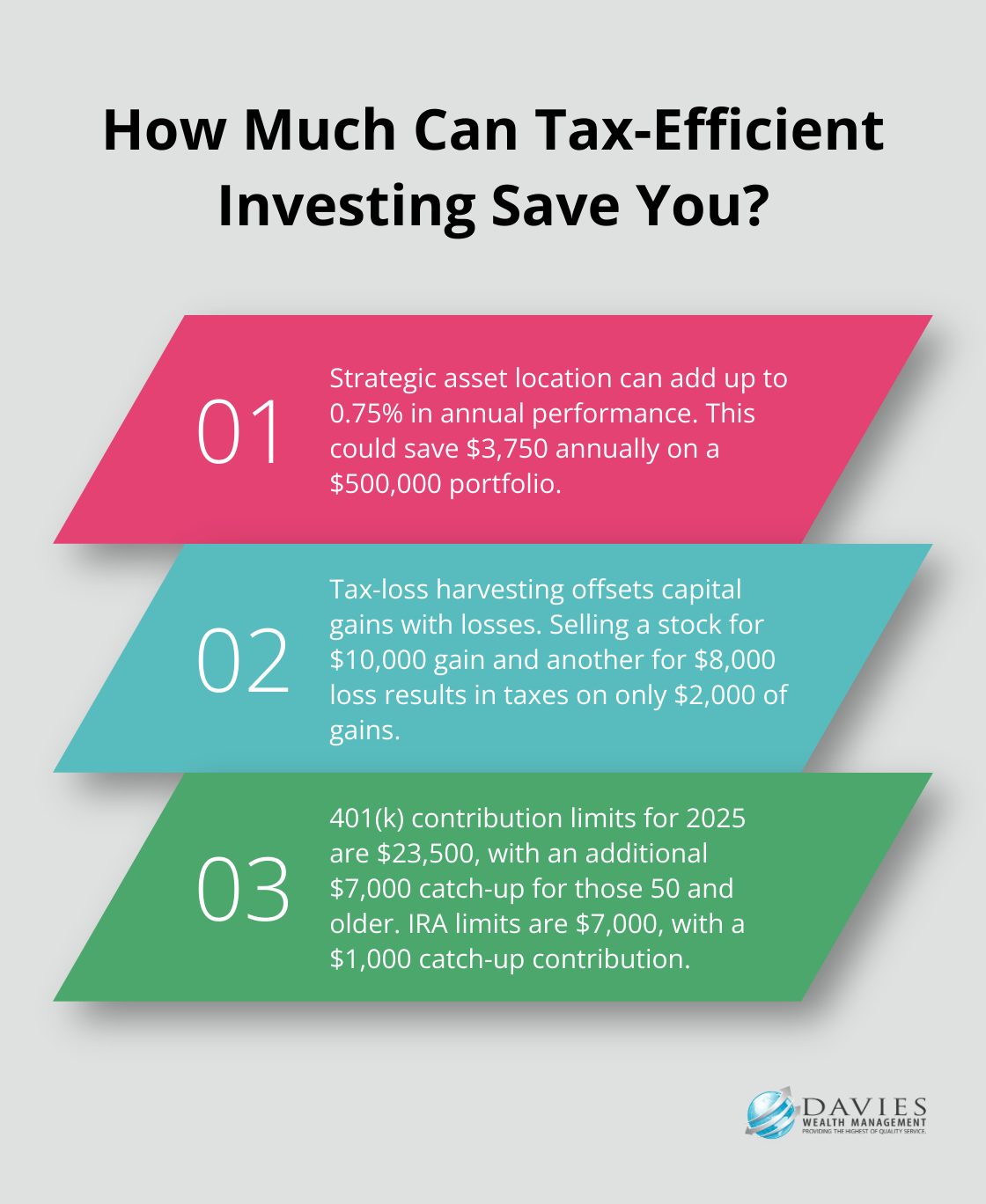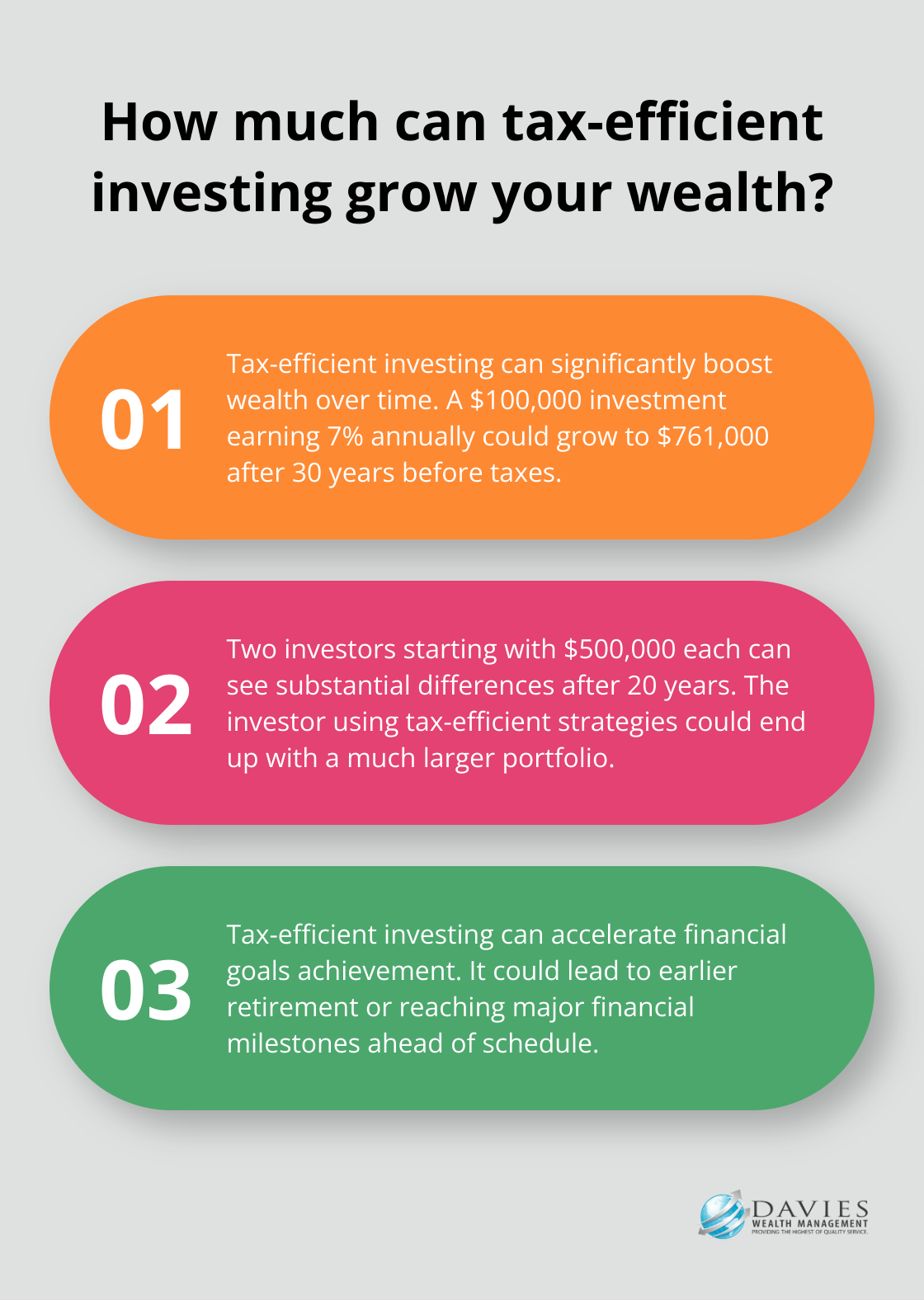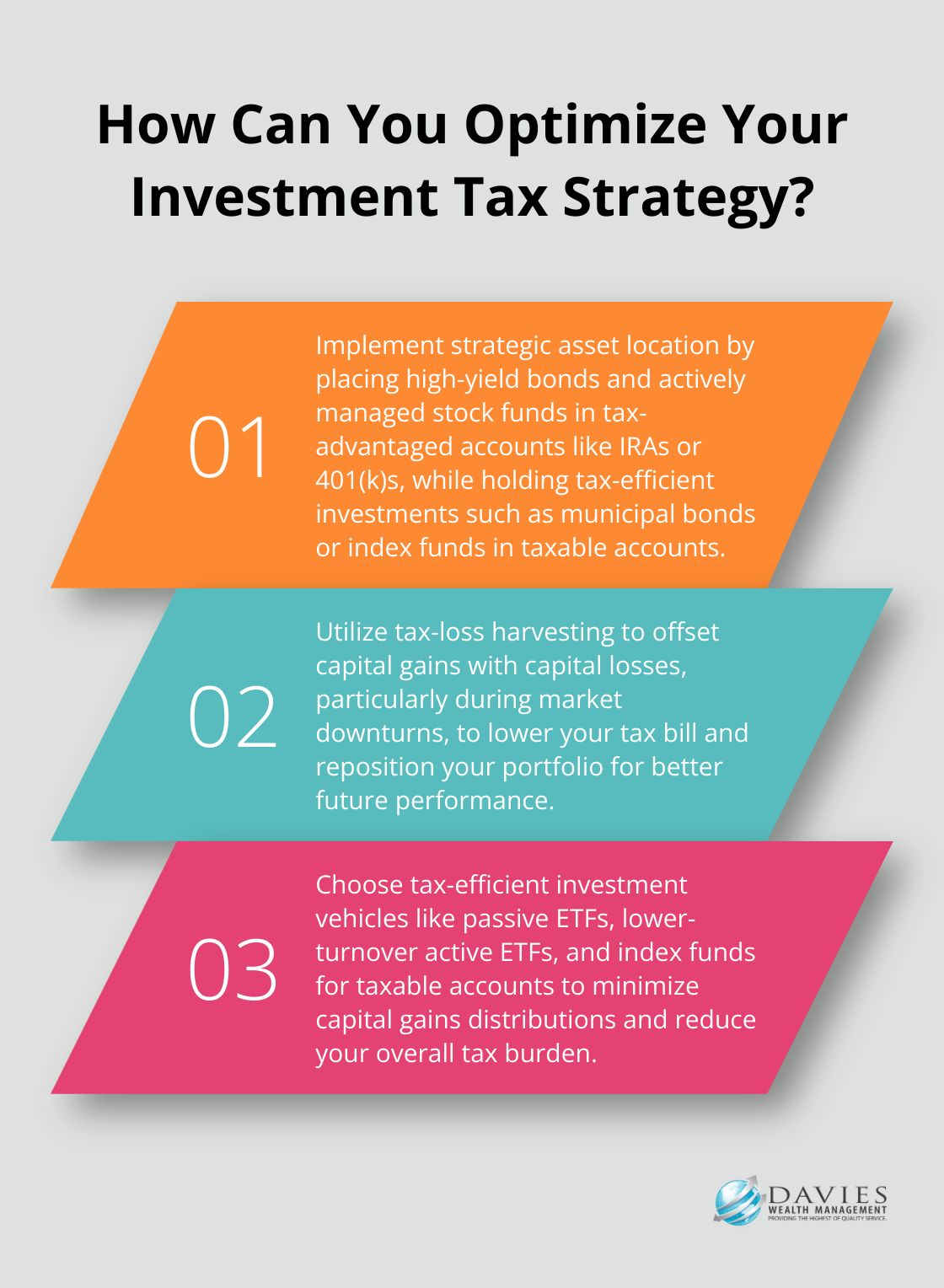Tax-efficient investing is a powerful strategy that can significantly boost your long-term wealth. At Davies Wealth Management, we’ve seen firsthand how smart tax management can make a substantial difference in our clients’ investment outcomes.
One often overlooked aspect is tax-efficient investing in brokerage accounts, which can help minimize your tax burden and maximize your after-tax returns. In this post, we’ll explore the key principles of tax-efficient investing and provide practical strategies to help you keep more of your hard-earned money.
What Is Tax-Efficient Investing?
Definition and Core Principles
Tax-efficient investing is a strategy that maximizes returns by limiting losses to taxes. This approach focuses on keeping more money working for you, rather than losing it to unnecessary taxes. At Davies Wealth Management, we help our clients implement these strategies to maximize their after-tax returns.
The Impact of Taxes on Investment Returns
Taxes can significantly erode investment gains. For example, if you’re in a high tax bracket and earn a return on your investments, a substantial portion of that return could be lost to taxes. This tax drag compounds over time, potentially costing you significant amounts in the long run.
The Importance of After-Tax Returns
When evaluating investment performance, many investors focus solely on pre-tax returns. However, what truly matters is how much money you keep after taxes. This is where the concept of after-tax returns becomes essential.

For instance, a municipal bond yielding a lower tax-free return might be more valuable than a corporate bond yielding a higher return that’s subject to taxation, depending on your tax bracket. Understanding and prioritizing after-tax returns leads to more informed investment decisions and better long-term outcomes.
Practical Strategies for Tax-Efficient Investing
One effective strategy involves understanding the two main types of investment accounts: taxable and tax-advantaged. Investors should review the tax obligations associated with different investment options to make informed decisions.
Another approach considers exchange-traded funds (ETFs) over mutual funds in taxable accounts. ETFs typically generate fewer capital gains distributions, which can result in lower tax bills.
The Power of Strategic Asset Location
Strategic asset location is a key component of tax-efficient investing. This involves placing investments in the most tax-advantageous accounts based on their tax characteristics. For example, holding certain investments in a tax-deferred account can shield the income from current taxation.
As we move forward, we’ll explore specific tactics you can use to enhance the tax efficiency of your portfolio, including tax-loss harvesting and the effective use of tax-advantaged accounts.
How to Implement Tax-Efficient Investing Strategies
Strategic Asset Location
At Davies Wealth Management, we have developed a set of powerful strategies to help our clients maximize their after-tax returns. One of the most impactful strategies is strategic asset location. This involves placing investments in accounts that offer the most favorable tax treatment for that particular asset. For example, high-yield bonds or actively managed stock funds (which tend to generate more taxable income) are often better suited for tax-advantaged accounts like IRAs or 401(k)s. On the other hand, tax-efficient investments such as municipal bonds or index funds can be held in taxable accounts.

A study by Vanguard indicates that proper asset location can add up to 0.75% in annual performance. Over time, this can translate to significant savings. For instance, if you have a $500,000 portfolio, this strategy could potentially save you $3,750 in taxes annually.
Leveraging Tax-Loss Harvesting
Tax-loss harvesting is another powerful tool in the tax-efficient investor’s arsenal. This strategy involves offsetting capital gains with capital losses, which can lower your tax bill and better position your portfolio going forward.
For example, if you sold a stock for a $10,000 gain and another for an $8,000 loss, you’d only owe taxes on $2,000 of gains. This strategy can be particularly effective during market downturns, allowing you to turn temporary losses into tax savings.
Maximizing Tax-Advantaged Accounts
The use of tax-advantaged accounts is a cornerstone of tax-efficient investing. These include 401(k)s, traditional IRAs, and Roth IRAs. Each offers unique tax benefits:
- 401(k)s and traditional IRAs allow for tax-deductible contributions and tax-deferred growth.
- Roth IRAs offer tax-free growth and withdrawals in retirement.
In 2025, the contribution limit for 401(k)s will be $23,500, with an additional $7,000 catch-up contribution for those 50 and older. For IRAs, the limit will be $7,000, with a $1,000 catch-up contribution. Maximizing these accounts can lead to substantial tax savings over time.
Choosing Tax-Efficient Investment Vehicles
The selection of tax-efficient investment vehicles is essential. Passive ETFs and lower-turnover active ETFs are generally the most tax-efficient options, while active mutual funds tend to be less tax-efficient.
Index funds are another excellent option for tax-efficient investing. These passive investment vehicles generally have lower turnover rates and distribute fewer capital gains than actively managed funds.
The implementation of these tax-efficient investing strategies can potentially help you keep more of your investment returns and accelerate your progress towards your financial goals. In the next section, we will explore the long-term impact of these strategies on wealth accumulation and how they can significantly affect your financial future.
How Tax-Efficient Investing Boosts Your Wealth
The Power of Compound Growth
Tax-efficient investing transforms your financial future by harnessing the power of compound growth. This strategy doesn’t just save you money on taxes; it amplifies your wealth over time. While the impact of tax-efficient investing can vary, it’s important to consider its potential benefits in your overall financial planning.

Let’s illustrate this with numbers. If you invest $100,000 in a portfolio earning an average of 7% annually, after 30 years, you’d have about $761,000 before taxes. However, if you boost that return through tax-efficient strategies, you could potentially end up with a significantly larger sum.
Real-World Impact on Investment Portfolios
To understand the real-world impact of tax-efficient investing, consider this hypothetical case study. Two investors start with $500,000 each, earning an 8% annual return before taxes.
Investor A uses a tax-efficient strategy, resulting in a lower effective tax rate on investment income. Investor B doesn’t focus on tax efficiency and faces a higher tax rate on investment income.
After 20 years, Investor A’s portfolio could grow to a substantially larger amount compared to Investor B’s portfolio, demonstrating the potential impact of more efficient tax management.
Accelerating Financial Goals
Tax-efficient investing doesn’t just grow your wealth; it helps you reach your financial goals faster. For example, if you’re saving for retirement, the extra growth from tax-efficient strategies could mean retiring earlier or with a larger nest egg.
Some clients achieve their financial milestones sooner than expected by implementing these strategies. This could lead to reaching major financial goals, such as purchasing a dream home, ahead of schedule.
Professional Athletes and Tax-Efficient Investing
For professional athletes (where career spans can be short and unpredictable), tax-efficient investing plays a vital role. It allows them to maximize their earnings during peak years and build a sustainable financial foundation for life after sports.
Tax-efficient strategies help athletes:
- Manage irregular income streams
- Minimize tax burdens during high-earning years
- Create long-term financial stability
The Long-Term Advantage
The true power of tax-efficient investing becomes evident over time. As your wealth grows, so does the impact of tax savings. This compounding effect can lead to substantial differences in wealth accumulation over decades.
For instance, a 35-year-old investor who implements tax-efficient strategies might see their portfolio grow significantly by retirement age, potentially outperforming a similar investor without these strategies. This difference could significantly impact retirement lifestyle and financial security.
Final Thoughts
Tax-efficient investing empowers investors to maximize their after-tax returns and accelerate wealth accumulation. Strategic asset location, tax-loss harvesting, and the use of tax-advantaged accounts form the foundation of this approach. These strategies prove particularly effective for tax-efficient investing in brokerage accounts, where careful management can yield substantial tax savings over time.

Davies Wealth Management specializes in implementing tax-efficient strategies tailored to each client’s unique financial situation. Our team of experts navigates the complexities of tax laws and investment vehicles to create personalized plans that align with your goals. We work diligently to ensure your investment strategy not only maximizes returns but also minimizes tax liabilities.
Davies Wealth Management offers comprehensive wealth management solutions designed to build, protect, and transfer your wealth with confidence. Our commitment to personalized service and long-term relationships means we adapt your strategy as your life and financial goals evolve. We invite you to partner with us and harness the full potential of tax-efficient investing for a more secure financial future.
✅ BOOK AN APPOINTMENT TODAY: https://davieswealth.tdwealth.net/appointment-page
===========================================================
SEE ALL OUR LATEST BLOG POSTS: https://tdwealth.net/articles
If you like the content, smash that like button! It tells YouTube you were here, and the Youtube algorithm will show the video to others who may be interested in content like this. So, please hit that LIKE button!
Don’t forget to SUBSCRIBE here: https://www.youtube.com/channel/UChmBYECKIzlEBFDDDBu-UIg
✅ Contact me: TDavies@TDWealth.Net
====== ===Get Our FREE GUIDES ==========
Retirement Income: The Transition into Retirement: https://davieswealth.tdwealth.net/retirement-income-transition-into-retirement
Beginner’s Guide to Investing Basics: https://davieswealth.tdwealth.net/investing-basics
✅ Want to learn more about Davies Wealth Management, follow us here!
Website:
Podcast:
Social Media:
https://www.facebook.com/DaviesWealthManagement
https://twitter.com/TDWealthNet
https://www.linkedin.com/in/daviesrthomas
https://www.youtube.com/c/TdwealthNetWealthManagement
Lat and Long
27.17404889406371, -80.24410438798957
Davies Wealth Management
684 SE Monterey Road
Stuart, FL 34994
772-210-4031
#Retirement #FinancialPlanning #wealthmanagement
DISCLAIMER
The content provided by Davies Wealth Management is intended solely for informational purposes and should not be considered as financial, tax, or legal advice. While we strive to offer accurate and timely information, we encourage you to consult with qualified retirement, tax, or legal professionals before making any financial decisions or taking action based on the information presented. Davies Wealth Management assumes no liability for actions taken without seeking individualized professional advice.



Leave a Reply